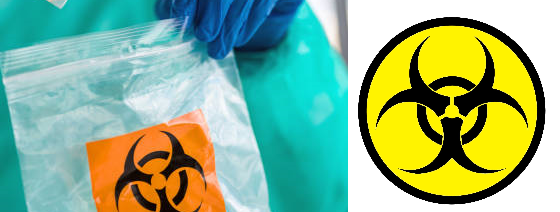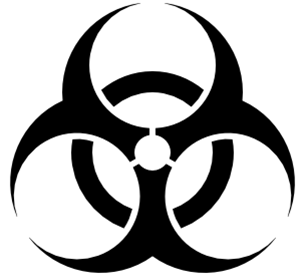Bioterrorism is simply defined as the unauthorized, threatened, and deliberate use of microbes (including bacteria, fungi or viruses) and their products (e.g. spores and toxins) as well as other biological and toxic substances or materials to cause death or disease in human populations, plants or animals. It is the use of microorganisms and other biological agents for aggressive or hostile purposes as against international laws regarding the usage of such agents. The term is often synonymous to chemical warfare – which is the use of harmful chemicals including nerve gas (e.g. sarin), chlorine gas and mustard gas to cause death in a human population.
Chemical weapons are toxic mixtures of chemicals that cause death, temporary incapacitation, or permanent harm in a human population through their chemical actions in life processes. Following the atrocious number of deaths that trailed World War I, the 1925 Geneva Protocol prohibited the use of chemical weapons on battlefield due to the abysmal number of deaths that followed their usage. The use of chemical, biological, radiological, nuclear, and explosive weapons (CBRNE) still remains a persistent (though less earth-shattering at the moment) menace to global security and health.
Bioterrorism is a global public health threat, and its apparent existence in warfare and terrorism is real. It is terrorism that involves the planned use, dissemination and release of biological agents and destructive chemicals as warfare tools (or offensives) in a defined human population in order to cause death. Agents used in bioterrorism attacks are weapons of mass destruction because they affect and kill people in their millions when administered even in very small amounts, and they are usually inexpensive and easy to use.
According to the U.S. Center for Disease Control and Prevention (CDC), a bioterrorism attack is the deliberate release of viruses, bacteria, toxins or other harmful agents used to cause illness or death in people, animals, or plants. Usually, biological agents and chemicals used for bioterrorism assaults according to the CDC are generally engineered by way of transformation in order to increase their ability to cause disease, make them more resistant to current available medicines, and to increase their ability to be spread into the environment unnoticed.
In their natural forms, biological agents (including viruses, bacteria and fungi) are not biological weapons until they have been engineered and transformed by way of mutation in order to weaponize and get them ready for dissemination to a target human or animal population where they eventually cause disease and death. Bioterrorism is an act of biological warfare.
Biological warfare is the use of chemical and biological agents to cause sickness or kill a defined civilian or military population during war. A biological weapon can be as devastating as the explosion of a nuclear weapon, and this also applies to chemical weapons such as nerve gas (for example sarin) amongst others. Both chemical and biological agents used in acts of terrorism can lead to serious public health impediments because it will be difficult to restrict the amount of damage and fatalities that will ensue from such an attack due to the quick spread of these agents.
Notably, biological agents are usually dispersed in aerosol forms, and these are inhaled by unsuspecting persons. Signs and symptoms follow later, resulting in sickness and death. An international surveillance program is crucial to contain the development and usage of biological and chemical agents in warfare across the world.
Biosurveillance is simply defined as the art of detecting disease outbreak during a bioterrorism attack or a natural epidemic occurrence in a defined human population in real-time.
Though scientists and those saddled with the responsibility of public health including the government and policy makers may not know beforehand which strain of biological agent or which chemical agent will be used in the next bioterrorism or when the next pandemic of infectious disease outbreak will occur, biosurveillance will help all stakeholders to know what the stakes are and what the terrorists, government or any unprincipled private organization in possession of or anticipating the development of biological agent for mass destruction are actually up to.
In the event of a chemical or biological attack, victims could become toxically infected for days without even knowing it because signs and symptoms of such attack might take some time to appear.
Usually, health practitioners and microbiologists handling patient’s specimens might be the first to alert the authorities about a possible biological attack due to new developments in the prognosis of their patients and sample evaluations respectively. In the event of such biological attack on humanity, speed in deciphering the agent used and the possible remedy to contain it is very essential to fast-track and contains or minimizes the casualties.
Health experts, scientists, and governments of nations must be proactive and always be on the alert for a counterattack against bioterrorism as a sense of urgency grows towards this menace – owing to the growing spade of acts of terrorism across the globe especially in Africa and the Middle East.
Stronger and better containment measures, robust medical treatment and rapid development and distribution of potent vaccines to victims of bioterrorism are critical to assuage the rage of a possible attack on humanity using biological or chemical agent. Different reasons abound for the use of biological and chemical weapons as military offensives and this may include political and religious ideologies.
Bioterrorism can also be criminally motivated by private organizations, individuals and terrorists organizations either to push a demand or show their strength in military might. Infectious biological agents are usually confined within the walls of medical laboratories under protective conditions where they are presumed safe. However, these agents can be intentionally released from their confinement and such unethical practice poses a huge public health issue to human population.
An extensive preparation and stockpiling of biological/chemical weapons actually took place in the 20th century by some major powers of the world, and this was largely attributed to uncertain military retaliation, threats or defense from rogue nations in possession of these weapons of mass destruction. Some nations of the world with stockpiles of chemical and biological weapons including those with putative biological and chemical weapons program include North Korea, Iran, France, UK, Germany, Syria, Iraq, China, Libya, Egypt, Russia, South Korea, India, and South Africa.
Though planning towards a possible counterattack of a possible biological/chemical warfare based on available and known chemical and biological agents may not be feasible, a strategic global and national preparedness and response towards such possibilities and even in the face of such actual bioterrorism attack is crucial to limiting the number of casualties that will result from such offensives.
ATTRIBUTES OF BIOLOGICAL WEAPONS
To be effective for bioterrorism, biological agents and other chemical agents used for this purpose must meet certain criteria which necessitates their usage as potential tools for biowarfare.
Some of the characteristics of biological agents (i.e. microbes) used as biological weapons include:
- They are usually available and inexpensive.
- They are easy to grow and produce.
- They are easy to distribute.
- They have low visibility.
- They are highly infectious, and can be easily transmitted from person-to-person.
- They are safe to use by terrorists and offending soldiers.
- They cause consistent health damage or sickness in human populations.
- They cause sickness and death in human populations.
- They are highly pathogenic for animals, livestock or poultry.
References
Aschengrau A and Seage G.R (2013). Essentials of Epidemiology in Public Health. Third edition. Jones and Bartleh Learning,
Aschengrau, A., & G. R. Seage III. (2009). Essentials of Epidemiology in Public Health. Boston: Jones and Bartlett Publishers.
Castillo-Salgado C (2010). Trends and directions of global public health surveillance. Epidemiol Rev, 32:93–109.
Centers for Disease Control and National Institutes of Health (1999). Biosafety in Microbiological and Biomedical Laboratories, 4th edn, Washington DC: CDC.
Guillemin J (2006). Scientists and the history of biological weapons. European Molecular Biology Organization (EMBO) Reports, Vol 7, Special Issue: S45-S49.
Halliday JE, Meredith AL, Knobel DL, Shaw DJ, Bronsvoort BMC, Cleaveland S (2007). A framework for evaluating animals as sentinels for infectious disease surveillance. J R Soc Interface, 4:973–984.
Nelson K.E and Williams C (2013). Infectious Disease Epidemiology: Theory and Practice. Third edition. Jones and Bartleh Learning.
Porta M (2008). A dictionary of epidemiology. 5th edition. New York: Oxford University Press.
Rothman K.J and Greenland S (1998). Modern epidemiology, 2nd edition. Philadelphia: Lippincott-Raven.
Rothman K.J, Greenland S and Lash T.L (2011). Modern Epidemiology. Third edition. Lippincott Williams and Wilkins, Philadelphia, PA, USA.
Discover more from #1 Microbiology Resource Hub
Subscribe to get the latest posts to your email.



